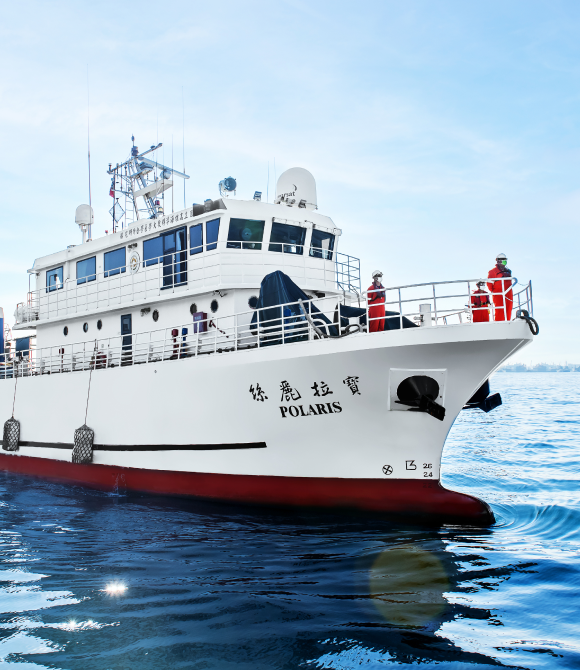
Slowly departing from Taiwan's strong festive atmosphere, the ocean exploration vessel "Polaris" set sail from the Cijin Campus of National Kaohsiung University of Science and Technology on the night before Lunar New Year’s eve, February 14th this year (2018), fully engaged in salvaging the wreckage of the Air Force's Black Hawk helicopter, NA-706, which had crashed into the sea. After fifty-seven days and nights of waiting, with solemn hearts, the Black Hawk helicopter and the two bodies were finally recovered from a depth of nearly a thousand kilometers in the southwest of Orchid Island.
After the successful salvage of the Black Hawk helicopter on April 12th, the Aviation Safety Council, which outsourced the salvage operation, praised it as the first such operation of its kind in Taiwan and rare even on a global scale. The salvager company was the local Dragon Survey which made Taiwan look like a maritime country. In an interview with Dragon Survey's General Manager, Dragon Hsi, with “The Journalist”, he discussed in detail the difficulties of the salvage process and Taiwan's world-class salvage technology.
Dragon Hsi stated that the most important aspect of salvage operations is to first accurately "locate" the wreckage; otherwise, it is like looking for a needle in a haystack and a waste of time. Although Dragon Survey had previous experience in searching for F-16 fighter jets and salvaging planes, with a maximum depth of only over 400 meters, this time they were informed that the helicopter wreckage was located about 30-40 meters underwater near Orchid Island. However, after entering the operation, while searching for the helicopter's black box (Flight Recorder) beacon signal on the sea surface, it was discovered that the wreckage had fallen into a trench nearly 1,000 meters deep. Later, they used a "deep tow system" and an "ROV" to carry out the operation and finally located the wreckage.
What impact does different depths have on the difficulty of salvaging? According to Dragon Hsi, the deeper the depth, the more important the quality of the salvage equipment and the operational skills become. The deep-tow system and ROV used in the salvaging of the aircraft wreck are key components that allow Dragon Survey to compete with only two or three other salvage companies in the world.
Dragon Hsi pointed out that the deep tow system connects a "towfish" to the Polaris with a 3,000-meter-long cable. The towfish is equipped with side-scan sonar, multibeam echosounder, and hydrophones, which are operated by personnel on board the ship to detect the wreckage as close to the seabed as possible.
In addition, Polaris' crew must also battle harsh weather conditions, endure extreme cold and rough seas. Dragon Hsi pointed out that due to the need not to face big waves, sometimes Polaris has to go back to the harbor so that the actual salvage operation took less than thirty days, with five round trips, including three for locating the wreck and two for salvaging. The process was disrupted by a typhoon, which caused the already located wreck to wait on the seabed for almost half a month.
How did Dragon Survey develop top-notch technology in salvaging aircraft wrecks about ten years ago? Dragon Hsi said that the parent company of Dragon Survey has been an agent of marine survey equipment for over ten years. With enthusiasm and drive, Dragon Survey collaborated with National Kaohsiung University of Science and Technology to develop a multifunctional marine survey vessel, sought guidance from Chan-Chuan Wen, and built Polaris and its on-board survey equipment, and started its salvaging business.
Dragon Survey has sought guidance from foreign ROV operators to become familiar with difficult operations, but most of its salvaging techniques were developed through trial and error. Dragon Hsi shared that the company's main business is usually to explore underwater terrain, such as 3D underwater models and soil measurements, with an operating range of up to 7,000 meters underwater.
One time, Dragon Survey was commissioned to use a deep-tow system to explore the seabed outside the Zhiben Hot Springs in Taitung. The terrain was complex and steep, so Dragon Survey sought the help of a technician from a Portuguese marine surveying company to serve as a consultant. The technician praised them, saying, "I've been running around the world for over a decade, and only you guys dare to use the deep-tow system like this. It's like going crazy."
This time, Dragon Survey dispatched an ROV that can operate at a depth of up to 1,500 meters, and they have another ROV that can reach up to 3,000 meters. Dragon Hsi pointed out that in addition to four or five personnel from the Aviation Safety Council, Dragon Survey also dispatched 15 staff members responsible for tasks such as vessel navigation, sonar identification, and ROV operation, and all ROV operators have more than ten years of experience.
Undertaking deep-sea salvage operations requires both skill and courage since it carries significant risks. Dragon Hsi explained that there are many risks when dragging fish or an ROV into the water, "We can't guarantee that we'll be able to recover them. Apart from underwater terrain, they may also encounter drifting objects such as fishing nets that could get caught in the thrusters." Dragon Hsi emphasized that the trawling equipment costs millions of dollars, and the ROV even costs tens of millions of dollars. " In the past Dragon Survey has also had equipment dropped into the sea, and it's inevitable that there will be some anxiety, but we've always been able to recover our equipment and we have confidence in our techniques to differentiate from others"
Read more: the Storm Media